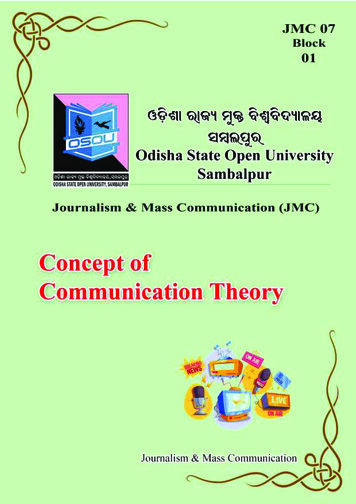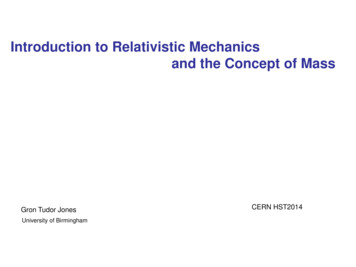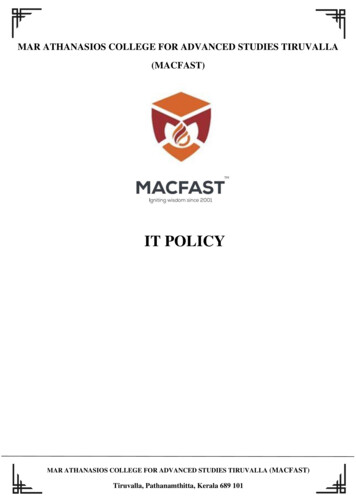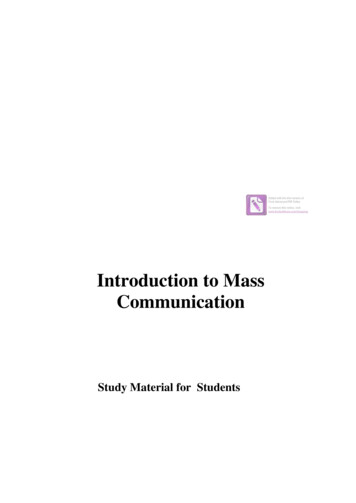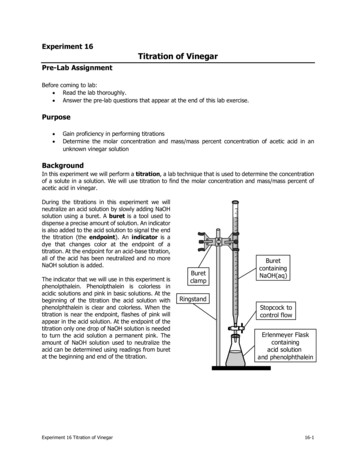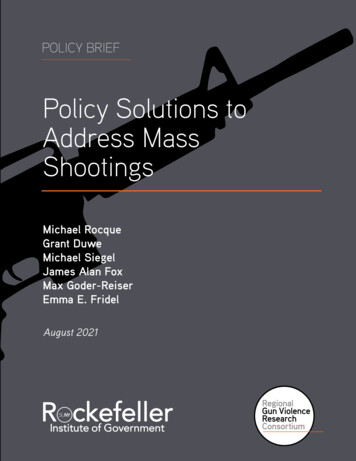
Transcription
POLICY BRIEFPolicy Solutions toAddress MassShootingsMichael RocqueGrant DuweMichael SiegelJames Alan FoxMax Goder-ReiserEmma E. FridelAugust 20211
SYNOPSISThis project was supported by grant#2018-75-CX-0025, awarded by theNational Institute of Justice, Office ofJustice Programs, US Departmentof Justice. The opinions, findings,and conclusions or recommendationsexpressed in this publication are thoseof the authors and do not necessarilyreflect those of the Department ofJustice.In the past decade, mass shootings,particularly those that take placein public areas, have increasinglybecome part of the nationalconversation in the United States.Mass public shootings instillwidespread fear, in part becauseof their seeming randomness andunpredictability. Yet when theseincidents occur, which has been withsomewhat greater frequency andlethality as of late, public calls forpolicy responses are immediate. Inthis policy brief, we review effortsto evaluate the effect of gun controlmeasures on mass public shootings,including a discussion of our recentlypublished study on the relationshipbetween state gun laws and theincidence and severity of theseshootings. The findings of this workpoint to gun permits and bans onlarge capacity magazines as havingpromise in reducing (a) mass publicshooting rates and (b) mass publicshooting victimization, respectively.Interestingly, however, most gun lawsthat we examined, including assaultweapon bans, do not appear to becausally related to the rate of masspublic shootings.ABOUT THE AUTHORSMichael Rocque is an associateprofessor of sociology at BatesCollegeGrant Duwe is the director ofresearch and evaluation at theMinnesota Department of CorrectionsMichael Siegel is a member of theRegional Gun Violence ResearchConsortium and a professor in theDepartment of Community HealthSciences at the Boston UniversitySchool of Public HealthJames Alan Fox is the Lipmanfamily professor of criminology, law,and public policy at NortheasternUniversityMax Goder-Reiser is a researchassistant in the Department ofCommunity Health Sciences at theBoston University School of PublicHealthEmma E. Fridel is an assistantprofessor in the College ofCriminology and Criminal Justice atFlorida State University2
POLICY SOLUTIONS TO ADDRESSMASS SHOOTINGSAfter a year in which the COVID-19 pandemic significantly changedmost aspects of social life—and even mass public shootings seemedto take pause—recent events remind us that these incidents havenot gone away. With four mass public shootings (in Metro Atlanta,GA; Orange, CA; Boulder, CO; and Indianapolis, IN) all within a onemonth time span this year, the problem has once again taken centerstage in the consciousness of the American public.When particularly deadly mass shootings take place, renewedattention is placed on the possible causes and potential solutionsthat could help the United States deal with this trenchant problem.Two of the most widely discussed factors often involve mentalillness and gun availability. In both areas, claims are often influencedby political and emotional factors.13
In this policy brief, we discuss gun control and mass shootings, drawing on a recentempirical study we conducted that focused on a specific type of mass shooting—thosethat occur in public settings.2 We first review definitions of mass shootings and thendiscuss issues related to identifying the effects of gun control measures. We concludewith an overview of our study and the implications it holds for future public policy.What Is a Mass Shooting?As another recent Rockefeller Institute policy brief noted, definitions of massshootings are not consistent in the media nor in the scholarly literature.3 Claimsthat “there were more mass shootings than days” generate a lot of attention, if notskepticism, particularly when compared to other estimates that are far lower.4 Thesource of the discrepancies—and the resulting confusion about prevalence—is thevarying definitions used by different databases and methods employed to collect data.5For example, some sources define mass shootings as incidents in which three ormore victims were shot and killed, not including the perpetrator,6 while others use athreshold of four.7 Some sources define a mass shooting as any incident in which fouror more were shot or injured, which greatly increases the incident count.8 Further,mass shootings are often differentiated according to where they took place, whothe targets were, and the motivations underlying them. Media coverage and fear ofmass shootings are higher for those incidents that occur in the public with relativelyrandom targets.9 Thus, some researchers focus on mass public shootings, defined asa shooting taking place in a public area with four or more deaths from gunfire withina 24-hour period and not linked to other criminal activity such as gang conflict, drugtrade disputes, or robberies. In part, this distinction arises because of the sense thatrandom massacres are qualitatively different than other, more profit-driven formsof crime. These public shootings with four or more fatalities represent roughly aquarter of all mass shootings in the US, according to the AP/USATODAY/NortheasternUniversity database.10Finally, some databases utilize public or open sources toidentify mass shooting incidents,11 whereas others usea triangulated approach, incorporating open sources aswell as official records from the government, such as theSupplementary Homicide Reports.12Being crystal clear about the definition of a mass shootingis not a trivial matter. It has important implications for theclaims being made about the numbers of mass shootings theUS has experienced as well as the factors that contributeto them. For example, our own federally-funded work hasfocused on mass public shootings in the US since 1976.From 1976 to 2020, we uncovered 165 distinct incidents ofmass public shootings with a total of 1,167 victims killed bygunfire, for an average of 7.1 victim fatalities per incident.4From 1976 to 2020, weuncovered 165 distinctincidents of mass publicshootings with a totalof 1,167 victims killed bygunfire, for an averageof 7.1 victim fatalities perincident.
Compare this to the Gun Violence Archive’s estimate of 2,957 incidents from 2013 to2020 with a total of 3,161 fatalities (some of which were the assailant’s death), for anaverage of 1.1 fatalities per incident. Clearly, these two databases are not focusing onthe same phenomenon. Table 1, below, illustrates a sample of varying definitions ofongoing data collection efforts regarding mass shootings.TABLE 1. Definitions of Mass Shootings by SourceDefinition of ShootingIncidentYearsIncludedFox/Duwe/Rocque4 victims killed by gunfirein public within 24 hoursexcluding n/Densley4 victims killed by gunfirein 4 victims killed by gunfireUniversity(a)2006-20203481,8835.4The Washington Post4 victims killed by gunfirein public excluding felonyrelated incidents1966-20201761,2467.1Everytown for Gun Safety4 victims killed by gunfire2009-20202361,3635.8Mother Jones(b)4 victims killed by gunfirein public excluding domestic/felony-related incidents1982-20201199578.0Gun Violence Archive(c)4 victims killed or injuredby gunfire2013-20202,9573,1611.1SchildkrautMultiple victims killed orinjured by gunfire in publicwithin 24 hours excludinggang violence or targetedmilitant or terroristic ictimsAverageFatally Victims perShotIncidenta The AP/USATODAY/Northeastern University database and the FBI Supplementary Homicide Reports alsotrack mass killings by means other than gunfire.b The victim fatality threshold used by Mother Jones was reduced to three in 2013; fatality countsoccasionally include offender deaths.c The fatality counts in the Gun Violence Archive include offender deaths.5
The definition that guides our work is: “An incident in whichfour or more victims excluding the perpetrator(s) are fatallyshot in a public location within a 24-hr period in the absenceof other criminal activity, such as robberies, drug deals, andgang conflict.”We focus on the types of mass shootings that generate themost fear and coverage in the media.13 We specifically chosethe long-standing four-victim threshold and based that onfatalities, not just injuries (which may be minor) to avoidconflating mass public shootings with less serious multiplevictim shootings that are less likely to draw attention. Thepublic and policymakers are concerned about more severemass public shootings—research shows that the moredeaths, the greater the attention. Thus, we wanted to isolatethe types of incidents that are likely to drive policy.Can Mass Shootings Be Prevented?The definition thatguides our work is: “Anincident in which four ormore victims excludingthe perpetrator(s) arefatally shot in a publiclocation within a 24-hrperiod in the absence ofother criminal activity,such as robberies,drug deals, and gangconflict.”Given the public’s considerable concern about massshootings and their tragic toll, policymakers areunderstandably looking for answers to why such incidents occur and how to stopthem.14 In the 1990s, when a spate of school shootings (which typically would fallunder the mass public shooting criteria) unfolded, the federal government began towork on school shooter assessments and prevention strategies. Published reportsindicated that much planning had often occurred prior to the attack and that theshooters frequently exhibited “concerning” behaviors beforehand. However, therewas not one profile that would adequately characterize the spectrum of schoolshooters.15Despite the tendency of observers in the US to focus on individual characteristicsof shooters, there is one social factor that never fails to enter the mass shootingprevention discussion: guns. There is a perception, backed by data, that the US “leadsthe world” in mass public shootings.16 Even the Gun Violence Archive makes this claim,stating that “mass shootings are, for the most part an American phenomenon.”17 Thus,some have looked to explanations of mass shootings that are unique to US culture.What is it about America, some ask, that leads to such high levels of mass violence?It could be, as some have pointed out recently, linked to our history of violence andturmoil, baked into the very DNA of the country.18The US has more guns per capita than most other comparable nations, with about 40percent of civilians owning or having access to a firearm in the home. Gun controlefforts are politically complex, given the 2nd Amendment to the US Constitution andmoney involved in supporting gun rights.19 Thus, whereas simply removing guns fromcivilians is not a viable solution, limiting access and increasing oversight on firearmaccess are possibilities that have been explored.6
Research Evaluating Gun Control Policies andMass ShootingsDiscussions about the prevention of mass public shootings do not often recognizethe wide range of policy approaches that could potentially be considered. Whileassault weapon bans and gun buybacks are often suggested immediately followinga particularly severe mass shooting, there are a broad array of potential policies thatcould potentially affect the overall availability of firearms to individuals who may beinclined to commit violent crime, and therefore the likelihood of a mass shooting.20Most gun control laws are not specifically meant to address mass shootings, but theassumption appears to be that since mass shootings are a subset of “ordinary” gunviolence, the laws would also be effective in reducing their incidence or severity. Butwhat does the research show?The Rand Corporation reviewed the literature concerning the impact of “right to carry”laws—which allow individuals to carry concealed weapons without a permit—onthe prevalence of mass shootings, finding mixed evidence.21 In one of the earlieststudies to examine whether such laws affect mass shootings, Duwe, Kovandzic, andMoody looked at whether shall issue laws (i.e., laws in which licenses for concealedweapons are provided so long as certain criteria are met) in the US from 1976-99 hadany influence on mass shooting incidents and severity, finding no evidence that theydid.22 More recently, Fridel found that more permissive, looser concealed carry lawshad a positive association with gun homicide rates from 1991 through 2016, but notwith mass shootings.23 However, her analysis did suggest that mass shootings wereelevated in states with more guns per capita.7
Perhaps no type of gun control legislation has been linked to mass shootings morethan so-called “assault weapons bans,” including the 1994 federal assault weaponsban (AWB). In March of 2021, in the wake of two mass public shootings in less than aweek, President Joe Biden stated that the 1994 Assault Weapons Ban “brought down.mass killings,” and then argued for a renewal of the law.24It is important to note what the 1994 bill did and did not do, before discussing itsassociation with mass shootings. The bill prohibited the possession, manufacture,or transfer of particular types of firearms that met the criteria for assault weapons,including characteristics such as large capacity magazines (LCM) holding more than10 rounds, or flash suppressors. However, an exemption allowed citizens to retaintheir guns if they were obtained prior to the passage of the bill.Several studies have examined the impact of the 1994 AWB on gun violence, in general,and mass shootings, in particular, with mixed results. Some work indicated that theban had little influence on gun violence25 and mass shootings of all types.26 At thesame time, other research has suggested that the ban did reduce the victim toll ingeneral mass shooting incidents,27 as well as mass public shootings,28 and that largecapacity magazines were linked to higher victim counts in public massacres.29 Theban on LCMs may help explain why some work has found the AWB reduced massshooting deaths.30 For example, focusing on LCM bans, some research has found thatthese policies tend to reduce the lethality of mass shootings.31Other studies have examined whether “permissiveness” of gun laws is related tothe rate of mass shootings, with mixed results.32 Lin and colleagues’ study foundno relationship between gun-law permissiveness and mass public shootings, whileReeping et al. examined mass shootings generally and did find that permissivenesswas related to a higher rate of such incidents.33 Thus, there is a lack of consensus onwhether strict gun laws influence mass shootings. In part, this is due to differencesin mass shooting data sources and variation in definitions of “permissiveness.” As wenoted, Lin and colleagues did not spell out how their permissiveness measure wascreated and it appeared to be based on concealed carry laws.34The logic behind laws such as requiring a permit to purchase a firearm or bans onlarge capacity magazines is clear: making it harder to access guns and limiting thenumber of rounds that can be fired easily and quickly should reduce the opportunity tocommit mass shootings and the number of people shot if one occurs. However, somedisagree with this reasoning and suggest that a focus on high capacity magazines ismisguided. For example, Kleck argued that large capacity magazines are rarely usedin mass shootings and that most of the time shooters are equipped with multiplemagazines.35 Thus, if the assailant wants to shoot a large number of people, they havethe means to do so, large capacity magazine or not.8
Virginia Tech massacre memorial on the campus of Virginia Tech.36Our Research on State Gun Laws and MassShootingsAs part of a National Institute of Justice-funded project, we sought to provideinformation on the association between state gun laws and mass public shootings.37We focused on public shootings because they are the most frightening, generatethe most media coverage, and usually result in the highest number of fatalities.38 Aspreviously stated, our definition of mass public shooting is as follows: “An incident inwhich four or more victims are fatally shot in a public location within a 24-hr periodin the absence of other criminal activity, such as robberies, drug deals, and gangconflict.”Our research expands on previous work in two primary ways. First, we took advantageof a comprehensive list of mass public shooting incidents and victim counts in the USfrom 1976-2018 along with a database of 89 state gun laws with transparent definitionsthat the authors had compiled. This improves upon previous work that utilized limiteddata on both mass shootings and gun laws.Over the course of the 43-year time period, we identified 156 unique mass publicshootings with 2,839 victims shot, of whom 1,090 died. The one incident in Washington,DC was eliminated from the analysis because of the focus on state gun laws. Thus,the final tally was 155 mass public shootings with 2,827 victims. We then narrowedthe analysis to eight gun laws that had been researched in previous mass shootingresearch and for which there was a logical connection to mass shootings. These laws,which are defined in the supplementary materials linked to our study, can be found inTable 2.39We conducted two sets of analyses: one to assess the influence of laws on theincidence of mass public shootings and another to assess the influence of relevantlaws on the severity of mass public shootings in terms of victim counts.9
TABLE 2. Description of State Firearm Laws ExaminedLawDetailed DescriptionStates with Law in 2018Assault weapons banLaw bans the sale of both assault pistols andother assault weapons.CA, CT, MD, MA, NJ, NYExtreme riskprotection orderlawLaw allows law enforcement officers (but notnecessarily family members) to initiate animmediate process to confiscate firearms fromindividuals deemed by a judge to representa threat to themselves or others. Law mustrequire the surrender and confiscation offirearms, including authorization for a searchand confiscation of the individual’s residenceCA, CT, DE, FL, IN, MD,MA, OR, RI, VT, WALarge capacityammunitionmagazine banLaw bans the sale of large capacity magazinesfor both pistols and long guns.CA, CO, CT, MD, MA, NJ,NY, VTMay issue lawLaw provides authorities with discretion indeciding whether to grant a concealed carrypermit, or the law bans all concealed weapons.CA, CT, DE, HI, MD, MA,NJ, NY, RIPermit requirementAll firearms may only be sold to and possessedby individuals with a valid license or permit topossess or carry firearms. This may or may notinclude requiring a firearm safety certificate andmust apply to both licensed dealers and privatesellers.CA, CT, HI, IL, MA, NJ, RIRelinquishmentrequired if personbecomesdisqualified from gunownershipLaw requires that upon becoming prohibitedfrom possessing a firearm, a person mustrelinquish all firearms in their possession. Thismust be a broad provision that covers most, ifnot all, categories of prohibited people.CA, CT, HI, IL, MA, NY, PAUniversalbackground checksIndividuals must undergo a background checkat point of sale to purchase any type of firearm.This may or may not include exemptionsfor buyers who have already undergone abackground check for a concealed carry permitor other licensing requirements.CA, CO, CT, DE, NV, NY,OR, RI, VT, WAViolentmisdemeanor lawLaw prohibits firearm possession by peoplewho have committed violent misdemeanorspunishable by less than one year ofimprisonment. Simple assault misdemeanorsmust be included. Does not count if there is anexplicit exemption for crimes punishable by lessthan one year of imprisonment.CA, CT, HI, MD10
What Did We Find?We first conducted regression analyses predicting the presenceor absence of a mass public shooting event by state and yearusing what are called generalized estimating equations. Theresults produced odds ratios, which can be interpreted as theeffect of predictors on the odds that a mass public shootingtakes place. Our analysis included two sets of variables thatcould affect the odds of a mass public shooting occurring.In addition to variables that represented state gun laws,control variables such as divorce and unemployment ratesrepresent economic and social factors that could contribute tomass shootings. Any odds ratio over one indicates a positiverelationship between the variable and the likelihood of a masspublic shooting. An odds ratio below one indicates a negativerelationship meaning the variable contributes to lowering thelikelihood of mass public shootings.We found that permitlaws were associatedwith a 60 percent lowerodds of a mass publicshooting across timeand place.Next, we examined which predictors influenced the number offatalities, given that a mass public shooting occurred, using azero-inflated negative binomial model. These models produceincidence rate ratios, which are interpreted similarly to oddsratios, but are specific to rates of fatalities.Figure 1 displays the odds ratios and incidence rate ratio forthe statistically significant variables (both control and gun lawvariables). The black points are for odds ratios from the firstmodel relating to public shooting occurrence and the red pointis the incidence rate ratio for the second model examining therate of fatalities.Our first set of results indicated that permit laws were relatedto fewer mass public shooting incidents, but no other lawshad an effect. Specifically, we found that permit laws wereassociated with a 60 percent lower odds of a mass publicshooting across time and place. Second, when examiningrates of fatalities, we found that large capacity magazine banswere related to fewer victims. Specifically, LCM bans wereassociated with a 38 percent reduction in fatal victimizationsand 77 percent reduction in nonfatal victimizations. However,none of the other laws were found to be associated either withthe incidence or severity of mass public shootings. We foundno evidence that assault weapon bans deter these events orreduce fatalities when such events occur. These findings areconsistent with previous work, but, as noted, research on thefederal assault weapons ban is mixed.11LCM bans wereassociated with a 38percent reduction infatal victimizations and77 percent reduction innonfatal victimizations.
FIGURE 1. Odds Ratios and Incidence Rate Ratios from Regressions Examining theEffect of Gun Laws and Control Variables on Mass Public ShootingsLegendOdds RatioIncidence Rate RatioLCM BanPermit RequirementAge-Adjusted TotalSuicide RateAge-AdjustedFirearm HomicideRateDivorce RateUnemployment RatePopulation (mil)0.00.10.20.30.40.50.60.70.80.91.01.11.2NOTE: The red dot is from the negative binomial regression predicting the numberof fatalities per mass public shooting. It was the only statistically significantvariable. Only statistically significant variables in the models are shown(p .05). The odds ratio for “Permit Requirement” is less than one, indicatinga negative relationship between the presence of such law and the predictedodds of a mass shooting incident. The incidence rate ratio for “LCM Ban”can be interpreted similarly to the odds ratios, but relates specifically to therate of casualties rather than the number of incidents. For a comprehensivediscussion of methods and results, please reference the original publishedstudy.40121.31.4
Policy RecommendationsWhile mass public shootings remain rare events, evidence is accumulating on thetypes of gun control measures that may be effective in reducing their incidenceand severity. Our research is consistent with previous studies41 suggesting that: (1)requiring a permit to purchase or possess a gun may reduce the incidence of masspublic shootings; and (2) banning large capacity magazines may reduce the number ofvictims when such a shooting occurs.As many as 10 states currently require a state-issued permit in order to purchaseor possess any type of weapon, including a handgun, long gun, or so-called assaultweapon. Several studies have demonstrated that permit laws reduce overall rates offirearm homicide.42 Thus, an increased difficulty in obtaining a gun appears to translateinto a decreased use of guns in the commission of crime. This same conceptualframework may explain our finding that states with permit laws experience a lowerrate of mass public shootings.The capacity of ammunition magazines may have a more logical connection to thenumber of casualties linked to a mass shooting because it determines the numberof times the assailant can fire without having to reload or switch to another firearm.Although reloading a magazine with a fresh clip or swapping firearms may take onlya few seconds, it does present an opportunity for would-be victims to escape and forbystanders or law enforcement to intervene. Despite this logic, though, research hassuggested interventions by the police or public have not occurred.43The mechanism linking permits and large capacity magazines to the incidence andseverity of mass public shootings is somewhat unclear. We suspect that laws thatmake it more difficult to obtain the type of weapon meant to kill large numbers ofpeople in a short period of time affect not only the ability to carry out such incidentsbut also the extent to which plans to commit such atrocities are translated into action.This may be the difference between high and low fatality mass shootings.While it might seem logical that banning the sale of assault weapons would reducethe incidence of mass public shootings, this conceptual hypothesis relies on theassumption that if not for the existence of assault weapons, an individual would notcarry out a planned mass shooting. We are aware of no evidence to suggest that apotential mass shooter would decide not to follow through with a planned shootingif assault weapons were not available on the retail or secondary markets. Moreover,the features that define an “assault weapon” are not necessarily relevant to the actuallethality of the firearm. Certain of the features that characterize an assault weaponare largely cosmetic: for example, a telescoping stock, a second pistol grip, a grenadelauncher, a bayonet lug, or a flash suppressor. Although these features may make aweapon look like a military-style rifle, they do not all directly translate into increasedlethality. What does translate into increased lethality, it seems—and the evidenceshows—is magazine capacity.13
The evidence on other gun control laws is inconsistent andwarrants further exploration. In addition, a straightforwardequation linking the overall number of guns to massshootings appears to be too simplistic. For example, in ourstudy, a measure of gun ownership (using a proxy) was notassociated with mass public shooting incidents. Access, onits own, does not appear to be the primary driver of theseevents.While laws such as universal background checks at pointof sale and violent misdemeanor laws were not associatedwith mass public shootings in our study that does not meanthey should not be implemented as a means of reducingviolent crime in general. The effects of backgroundchecks are somewhat unclear, but the Rand Corporationfound “moderate” effects of dealer background checks onreducing firearm homicides.44Decisions about implementing firearm laws should bebased not merely on whether they affect mass publicshootings but whether they influence more commonplaceforms of firearm violence, including both homicide andsuicide. While our study showed that permit laws and largecapacity magazine bans were associated with reductionsin the incidence and severity of mass public shootings,future work should explore additional types of laws as wellas continue to determine which laws reduce ordinary gunviolence more generally.14Decisions aboutimplementing firearmlaws should be basednot merely on whetherthey affect mass publicshootings but whetherthey influence morecommonplace formsof firearm violence,including both homicideand suicide.
ENDNOTES15
1Jonathan M. Metzl and Kenneth T. MacLeish, “Mental Illness, Mass Shootings, and the Politics ofAmerican Firearms,” American Journal of Public Health 105, 2 (2015): 240-9, 86/. Megan L. Ranney and Jessica Gold, “The Dangers of LinkingGun Violence to Mental Illness,” Time, August 7, 2019, s/. Hasin Yousaf, “Sticking to One’s Guns: Mass Shootings and the Political Economyof Gun Control in the United States,” Journal of the European Economic Association (March 30,2021), https://doi.org/10.1093/jeea/jvab013.2Michael Siegel et al., “The relation between state gun laws and the incidence and severity of masspublic shootings in the United States, 1976–2018,” Law and Human Behavior 44, 5 (2020): 1.pdf.3Jaclyn Schildkraut, Can Mass Shooting Be Stopped? To Address the Problem, We Must BetterUnderstand the Phenomenon (Albany, NY: Rockefeller Institute of Government, July 2021), tings-be-stopped/.4Jason Silverstein, “There were more mass shootings than days in 2019,” CBS News, January 2,2020, ore-than-days-365/.5James Alan Fox and Jack Levin, “Mass confusion concerning mass murder,” The Criminologist40, 1 (January/February 2015): 8-11, https://www.researchgate.net/publication/275333553 Massconfusion concerning mass murder.6Mark Follman, Gavin Aronsen, and Deanna Pan, “A Guide to Mass Shootings in America,” MotherJones, May 26, 2021, shootings-map/.7William J. Krousse and Daniel J. Richardson, Mass Murder with Firearms: Incidents and Victims,1999-2013 (Washington, DC: Congressional Research Service, July 30, 2015), ner,” Gun Violence Archive, accessed July 30, 2021, https://www.gunviol
the world" in mass public shootings. 16 Even the Gun Violence Archive makes this claim, stating that "mass shootings are, for the most part an American phenomenon." 17 Thus, some have looked to explanations of mass shootings that are unique to US culture. What is it about America, some ask, that leads to such high levels of mass violence?



